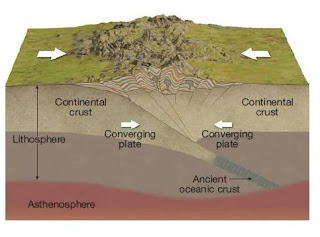 |
| Continent-continent convergence |
Mithra blew this basic concept of plate tectonics almost immediately, explaining in his/her/its introduction that, as far as S. knew,
"A subduction zone is a convergent boundary where two tectonic plates collide."
Well, no, that's not the whole story. Subduction zones occur at certain convergent boundaries, but not all. If this made us think that Mithra was ignorant of the topic, however, we were convinced by the next sentence:
"Plates are large, dense masses in [sic] the crust of the earth, the lithosphere, that float on top of liquefied rock in the asthenosphere..."
No, dumbass, the aesthenosphere is not "liquefied rock"! And as if that isn't enough, S. also favored us with this crapola:
"[Plates] are constantly shifting and moving, so when they subduct, one pushes beneath the other."
Geologists will point out that one overrides the other, not that one "pushes" under the other. With three egregious errors in the first paragraph, S. is already off to a bad start. Our nominee, however, continued to misinform any reader foolish enough to think that the author was either wise or a geek. Check out some of this rubbish:
- "Tectonic plates are categorized as either oceanic plates that have large bodies of water above them or continental plates that support land."
- "Subduction zones... recycle rock by melting it into magma so that crust might form at other tectonic zones."
- "When two oceanic plates meet, a deep underwater trench forms where the thicker plate plunges beneath the thinner one."
- "At first, great pressure at the thrusting plates causes earthquakes. These open up spaces to the hot, molten magma so it can push through in submarine volcanoes."
- "Sometimes, smaller plates may entirely disappear, eaten by the magma."
Earth Science types on staff are mortified by the level of ignorance contained in those five statements. Here's where Mithra got it wrong.
- Tectonic plates are classified according to the crust type that dominates, continental or oceanic. Even continental plates contain oceanic crust, though: the North American (continental) plate extends all the way to the center of the Atlantic Ocean. Mithra should be blathering about crust types, not plate types.
- The melted rock is NOT somehow transported to "other tectonic zones"; melted subducting crust and mantle become magma that forms igneous rocks either on the surface (volcanics) or in the subsurface (plutons).
- Mithra got that backward: denser crust subducts under lighter crust. Thickness has squat to do with it.
- We aren't certain what this "At first" business is about. Seismic activity occurs from the beginning of subduction until the collision is completed. That, and earthquakes don't "open up spaces" for magma; typically the movement of a magma body causes the seismic events.
- Apparently, S. thought there is a great sea of magma somewhere underground. Who knows?
Mithra's ignorance of things tectonic is part of a pattern, given that this is S's sixth Dumbass of the Day award, no two of which are in the same category. That makes S a sort of Bizarro-world version of a Renaissance Man like da Vinci, sort of an unRenaissance freelancer. Feh.
SI - TECTONICS
No comments:
Post a Comment